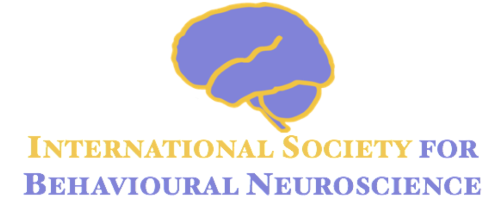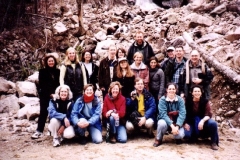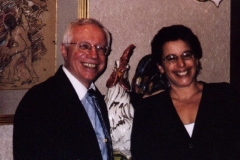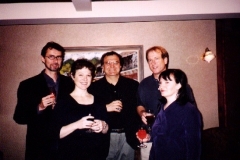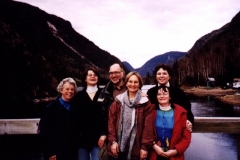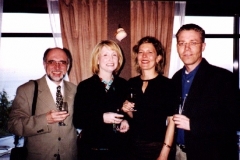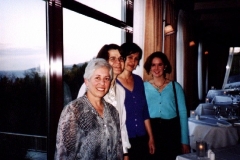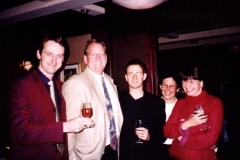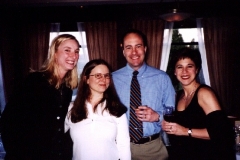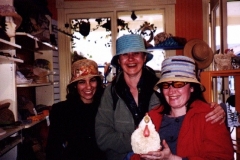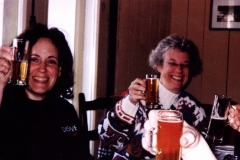Tenth Annual Meeting of ISBN
Date: May 18 – May 22, 2002
Place: Pointe-au-Pic, Quebec, Canada
Venue: Auberge des Falaises http://www.aubergedesfalaises.com/
Fun activities: Beluga watching
PROGRAM
Saturday, May 18
Welcome Dinner
Sunday, May 19
Symposium
The neural substrates of positive affective behaviour
Chairs: Adrian Owen and Angela Roberts
9:00-9:10 Introduction to session
9:10 Linking affect to action: Comparison of encoding in rat orbitofrontal cortex and amygdala. Geoffrey Schoenbaum Dept of Psychology, John HOPKINS UNIVERSITY, 3400 NORTH CHARLES ST, 25 AMES HALL, BALTIMORE, MARYLAND, 2128, USA.
Recent work in rats and primates shows that orbitofrontal cortex (OFC) and basolateral amygdala (ABL) are crucial to behavior based on the acquired incentive value of otherwise neutral cues. This presentation will consider the behavioral data that support this position and then turn to recent neurophysiological findings that shed light on the respective roles of these areas in mediating such goal-directed behavior. In one experiment, recordings of neurons were made in OFC and ABL of rats during learning and reversal of odor discrimination problems. Although neural activity in both structures reflected acquired incentive value during cue sampling, there were crucial differences between these representations in the two structures. Cells in OFC encoded incentive value in conjunction with odor identity and choice performance, whereas cells in ABL encoded incentive value before changes in performance and with less dependence on odor identity. These differences are consistent with the proposal that ABL encodes acquired incentive value while networks in OFC utilize this information in evaluating specific cues to guide performance. In a second experiment, OFC neurons were recorded in rats with bilateral neurotoxic lesions of ABL. ABL lesions disrupted encoding of incentive value in OFC. In ABL-lesioned rats, fewer OFC cells altered firing selectivity as a result of learning or reversal training, and more cells were selective simply on the basis of odor identity. ABL-lesioned rats also failed to show changes in approach latency likely related to incentive value and correlated with the emergence of selectivity in ABL in the first experiment. These results confirm the importance of connections between ABL and OFC in linking affective or incentive-based information to appropriate behavior.
9:55 Comparison of orbitofrontal, medial prefrontal and amygdala contributions to positive affective behaviour. Angela C Roberts. Department of Anatomy, University of Cambridge, Cambridge, CB2 3DY
While there is much evidence demonstrating that the orbitofrontal cortex and amygdala are critically involved in social and emotional behaviours, the nature of their interaction and their individual contribution to such behaviours is not well understood. In addition, even less is known about the contribution of ventral regions of the medial prefrontal cortex (including Brodmann’s areas, 25 and 32) to such behaviour, regions which also receive a relatively large input from the amygdala, have connections with the autonomic brainstem and have been implicated in certain affective disorders including depression. To address these issues we have recently developed a programme of research which compares the effects of excitotoxic lesions of the amygdala, orbitofrontal and medial prefrontal cortex on different aspects of positive affective behaviour in a new world primate, the common marmoset. This presentation will focus, in particular, on the contribution of these neural structures to conditioned reinforcement, which is the capacity of a conditioned stimulus to support instrumental behaviour by acquiring affective properties of the primary reinforcer with which it is associated. Such stimuli can maintain behaviour over protracted periods of time in the absence of, and potentially in conflict with, primary reinforcers. Data will be presented that support a role for the primate amygdala in the conditioned reinforcement process and which suggest that the orbitofrontal cortex, but not the medial prefrontal cortex may also be involved. Behavioural differences between the orbitofrontal and amygdala lesioned monkeys will be highlighted and considered in the light of the relative role of these two structures to affective behaviour.
10:40 Coffee Break
11:00 Learning to like: Investigating preference formation in humans. Ingrid Johnsrude
MRC Cognition and Brain Sciences Unit, 15, Chaucer Road, Cambridge, CB2 2EF, U.K
The study of reward learning in animals has revealed an interrelated set of limbic and cortical structures involved in reinforcement and motivation, and recent work is exploring how these systems exert effects on behaviour. Emotional associative learning has not yet been much investigated in humans from a similar neuroscientific perspective. Conditioned place preference is one of the most common procedures for assessing conditioned reward associations in animals, and we have developed an analogous procedure for use with people. We have used this procedure with several neuropsychological patient populations: the results of these studies are consistent with what has been reported in the animal literature about the brain substrates of reward learning. Our studies also provide new information regarding multiple, partially redundant, mechanisms of preference formation in humans, and suggest that there may be differences in the relative importance of these mechanisms, both from individual to individual and over the life span.
11:45 The role of the amygdala and orbital frontal cortex in the regulation of emotional responses to social and nonsocial stimuli, identification of facial cues, and decision-making abilities in macaques. J. Bachevalier
In both humans and monkeys, it is thought that the amygdala and orbital frontal cortex contribute critically to social cognition (Adolphs et al., 1998; Emery et al., 2001). Yet, their specific functions in this domain are poorly understood. In the last few years, we began to further examine the role of the amygdala and orbital frontal cortex in social cognition by combining selective lesion techniques and a newly designed battery of cognitive tasks in monkeys. The presentation will summarize our newest results on the effects of bilateral amygdala and orbital frontal lesions on emotional responsiveness, interpretation of facial cues, formation and maintenance of social bonds, and decision-making abilities. Our preliminary results indicate that monkeys with selective amygdala damage do not pay attention to relevant stimuli, such as faces, often ignoring the potential threat inherent in unfamiliar inanimate and social stimuli, and do not inhibit responses that do not satisfy their physiological needs, following instead their spontaneous exploratory and contact-seeking tendencies. Thus, the amygdala may be crucial for filtering out inappropriate behaviors that do not promote and strengthen social bonds. Data in monkeys therefore fit well with a current model positing the amygdala as part of a “continuous vigilance system, one that is preferentially involved in ambiguous learning situations of biological relevance” (Whalen, 1998). By contrast, animals with orbital frontal damage have difficulty differentiating between emotional expressions and are thus less confident and show a blunting of social interactions. They also do not change their food-choice strategies with respect to their current physiological states. The data indicate that the orbital frontal cortex may be critical for discriminating emotional cues from external stimuli as well as for discriminating changes in internal physiological states.
12:30 Neuronal activity during reward-related learning: insights from functional neuroimaging. John O’Doherty. Wellcome Department of Imaging Neuroscience, Institute of Neurology, University College London, U.K.
Two distinct components of reward processing are: an anticipatory component often signalled by the presentation of a cue that predicts the subsequent delivery of reward, and a consummatory component relating to reward receipt (Berridge, 1996). In the first part of this talk I will present evidence that the brain regions involved in reward anticipation are in part dissociable from those involved in responding to the receipt of the reward itself. In an fMRI study of reward expectation, posterior amygdala, ventral striatum and mid-brain dopaminergic nuclei were found to respond during the anticipation of reward but not during reward receipt. Orbitofrontal cortex was found to respond to the receipt of the reward, as well as during reward expectation. In the next part of the talk I will discuss one of the possible mechanisms by which areas involved in reward expectation come to represent the predictive value of a given cue with reference to a recent theoretical model of Pavlovian conditioning: temporal difference learning (Schultz et al. 1997). Central to this model is the notion of a prediction error (PE), that signals a discrepancy between expected future reward associated with a particular cue stimulus, and actual reward received on a given trial. One of the specific predictions about the characteristics of a neural signal that would represent a PE are that before learning, a positive PE response should occur to reward presentation, but during learning this response should shift to the time at which the cue stimulus is presented. I will present evidence from an event-related fMRI study that during learning, activity in ventral striatum and a region of orbitofrontal cortex does indeed shift in this manner during learning. Taken together, these studies demonstrate the utility of event-related fMRI as a means of establishing not only the functional neuroanatomy of reward processing, but also the neuronal dynamics underpinning these processes in the human brain.
1:15 LUNCH
AFTERNOON/EVENING IN BAIE ST. PAUL
Monday, May 20
8:25 Announcements and Welcome to Traditional Paper Session
8:30 Perceptual attentional set-shifting in the rat: effects of aging or posterior parietal damage. Mark G. Baxter*, Morgan D. Barense, and Matthew T. Fox. Department of Psychology, Harvard University, Cambridge, MA 02138, USA.
The capacity to shift attentional set between perceptual dimensions of stimuli is associated with the frontal cortex. Birrell and Brown (2000) have developed a set-shifting paradigm for rats that is sensitive to damage to different sectors of frontal cortex. In this task, rats learn to dig for a cereal reward in one of two identical cups that can be filled with different digging media and scented with different odorants. The presence of reward is consistently associated only with one element of the medium or odor dimension of each cup (counterbalanced across rats). After training on two problems in which the reward was consistently associated with the same stimulus dimension (medium or odor), and a reversal of one problem, a new problem is presented in which the reward is consistently associated with the previously irrelevant stimulus dimension (extra-dimensional shift/EDS). Damage to medial frontal cortex selectively impairs the EDS, whereas damage to orbital frontal cortex selectively impairs the reversal phase (Brown, 2002).
We examined the effects of normal aging on attentional set-shifting in this paradigm, as well as the effects of neurotoxic posterior parietal lesions in young rats. Normal aging is associated with disruption of neural systems that subserve different aspects of cognitive function, particularly hippocampus and frontal cortex; age-related changes in frontal cortex function in rats, however, have been under-studied. Aged (27-29 months old) male Long-Evans rats as a group were significantly impaired on the EDS relative to young (4 months old) rats. Some individual aged rats performed as well as young rats on this phase, indicative of individual differences in aging.
We were interested in the effects of posterior parietal lesions on this task because of an hypothesized role for this area in attentional function generally, and because it provides substantial input to medial frontal cortex. Rats with neurotoxic posterior parietal lesions were also impaired selectively on the EDS phase of the task. These results suggest that 1) the posterior parietal cortex and medial frontal cortex may form a functional network for perceptual attentional set shifting, and 2) normal aging in rats is associated with a disruption this cortical attentional network. Supported by NIA R03-AG17337.
8:45 Spatial conditional associative learning: The effects of lesions to the retrosplenial cortex in the rat. Annie Bélanger and Viviane Sziklas* Department of Neurology & Neurosurgery, McGill University, Montreal, Canada
Previous findings in our laboratory have shown that damage to the dorsal hippocampus or anterior thalamic nuclei lead to impairments on a spatial conditional learning task in which the rat is required to form associations between arbitrary scenes and particular cues embedded within them. Damage of the fornix does not result in impairments on this task, suggesting that hippocampo-thalamic interactions during the performance of this task depend on another, possibly cortical, link. There is evidence that the retrosplenial area in the posterior cingulate region may be a critical component in an indirect thalamohippocampal pathway as it has been shown to have connections with both the hippocampus and the anterior thalamic nuclear group.
Rats with neurotoxic lesions of the retrosplenial cortex and a group of unoperated control animals were tested on acquisition of a spatial-visual conditional associative learning (CAL) task in which they had to learn associations between a particular scene (or place) and one of two visual stimuli found within it. The animals were subsequently tested on a spatial working memory task, the radial arm maze, known to be sensitive to damage of the retrosplenial area. Rats with retrosplenial damage learned the CAL task at a rate comparable to control animals but showed a significant impairment in the acquisition of the working memory task. The findings suggest that while the retrosplenial cortex may be an important link in a hippocampo-thalamic pathway subserving spatial working memory, its role in spatial learning may be a selective one.
9:00 Assessing the neural and psychological mechanisms of taste preferences in the common marmoset. John A Parkinson
Choosing between several available rewards is a complex process both at the psychological and neural level. One significant contribution to such processes is made by the emotional, or affective, tone of reward-related stimuli. Research suggests that the amygdala (and its associated circuitry) contributes to affective processing and as such is hypothesised to play a role in attaching value to food rewards and subsequently guiding appropriate food choice and selection.
However, traditional attempts to study the role of the amygdala in food preferences have tended to yield negative results, other than an involvement in the initial neophobic response to novel foods. As such it is not clear what precise and potentially subtle contribution the amygdala makes to such preferences.
The present experiment revisits the role of the amygdala in taste preferences by utilising a computer automated touchscreen apparatus to allow precise control over experimental variables. Common Marmosets learnt to associate visual stimuli with tastes and then received either excitotoxic lesions of the amygdala or control surgery. In this ongoing study various manipulations are being made to differentiate any involvement of the amygdala specifically in the development and/ or retention of taste preferences per se, as well as in associations between visual stimuli and specific tastes, and in the way preferences may be influenced by changes in motivational state.
9:20 Effects of left inferior prefrontal stimulation on episodic memory encoding: A combined fMRI-rTMS study. Köhler, S., Paus, T., Buckner, R. L., and Milner, B.
Successful recovery of words from episodic memory relies on semantic processes at the time of encoding. Evidence from functional magnetic resonance imaging (fMRI) suggests that changes in neural activity in left inferior prefrontal cortex (LIPF) during semantic encoding predict subsequent memory performance. These correlational findings, however, do not establish a causal brain-behavior relationship. We conducted a two-part study that combined fMRI with repetitive transcranial magnetic stimulation (rTMS), the latter allowing us to manipulate neural processes in LIPF during encoding. We first used fMRI to localize, in each of 12 healthy individuals, activation in LIPF related to semantic encoding. We then administered rTMS in the same subjects during performance of the same encoding task. Using frameless stereotaxy, we stimulated the LIPF region that was activated during fMRI (mean xyz = -48 35 5), the homologous right-hemisphere region, and an additional left-parietal control site. At each site, stimulated items (600 ms of 7-Hz rTMS with Cadwell Round Coil) were intermixed with items presented without concurrent stimulation. Subsequently, subjects performed a recognition memory task for the words encountered. We found that the difference in recognition accuracy between stimulated and non-stimulated words for LIPF was significantly different from that for the other two sites. Whereas this difference was positive for LIPF, reflecting a region-specific facilitatory effect of rTMS on memory encoding, it was negative for the other sites, probably reflecting non-specific distraction due to peripheral rTMS effects. Our findings suggest a causal link between neural processes in LIPF at encoding and subsequent memory performance.
9:35 Volumetry of temporopolar, perirhinal, entorhinal and parahippocampal cortex from high-resolution MR images: considering the variability of the collateral sulcus. Jens C Pruessner, Stefan Kohler, Joelle Crane, Marita Pruessner, Catherine Lord, Andrea Byrne, Noor Kabani, D Louis Collins, and Alan C Evans. McConnell Brain Imaging Centre, Montreal Neurological Institute, McGill University, Montreal, Quebec, Canada
Researchers and clinicians frequently target structures of the medial temporal lobe (MTL) for volumetric analysis with Magnetic Resonance Imaging. In neurodegenerative diseases, the parahippocampal gyrus with temporopolar, entorhinal, perirhinal and parahippocampal cortex is often affected early in the course of the disease, and a precise volumetric analysis helps the differential diagnosis and can be used in guiding early treatment. In functional neuroimaging, the exact localization of cortices is the prerequisite for the correct interpretation of local activations with respect to specific memory functions.
However, precise and consistent volumetric analysis of these structures is compromised by the numerous segmentation protocols available for segmentation. In order to cover all structures of the MTL the researcher is forced to combine separate segmentation protocols from different laboratories at the cost of anatomical precision. The newly developed segmentation protocol presented here tries to address this issue by defining segmentation guidelines for the majority of the structures of the parahippocampal gyrus. Additionally, a method is presented to correct the volumes of entorhinal, perirhinal and parahippocampal cortex for the variability of the CS.
The protocol was developed using 40 healthy normal control subjects (20 men and 20 women, age range 18-42 years) recently scanned in our laboratory. Volumetric analysis was performed manually using in-house 3D software. Intra- and interrater coefficients are presented, together with mean values for all structures, correlations with age and gender, and tests for hemispheric differences.
9:55 Break
10:15 Cortical and subcortical mechanisms in human temporal motor sequence learning. Virginia Penhune1,3 and Julien Doyon2,3 1 Dept of Psychology, Concordia University2 Dept of Psychology, University of Montreal 3 McConnell Brain Imaging Centre, McGill University
A large number of studies in animals and humans have shown that motor cortical regions, the cerebellum and the BG are critically involved in learning skilled movements. Current models suggest that different networks of cortical and subcortical regions are referentially involved at the early and late phases of skill acquisition. Based on current evidence, Doyon and Ungerleider (2002) have hypothesized that early learning of motor sequences recruits a predominantly cerebello-cortical network, but that late learning and delayed recall may rely on a predominantly striato-cortical network. In a recent study, we used PET to examine learning and retention of timed motor sequences on three days: Day 1 of learning, after five days of practice (Day 5) and after a four-week delay (Recall). The results of this experiment revealed a dynamic network of motor structures that were differentially active during the early and late phases of learning and at delayed recall. Day 1 results revealed extensive activation in the cerebellar cortex, which decreased after five days of practice. Day 5 results showed increased activity in the basal ganglia (BG) and frontal lobe, with no significant cerebellar activity. At Recall, significantly greater activity was seen in M1, premotor and parietal cortex. Following up on this study we performed a second PET experiment which examined learning of the same timed motor sequence task across three blocks of practice on a single day. The results of this experiment showed a similar pattern of activation in the cerebellum during the initial block of learning, with decreasing activity across the three blocks of practice. When blood flow in the first and third blocks of practice were compared, greater activity was observed in the BG, M1 and parietal cortex, similar to the pattern of activation observed at late learning and delayed recall in the previous experiment. These results indicate that similar brain mechanisms may be active across short-term and long-term learning of motor sequences. This suggests that these cortical and subcortical systems subserve specific functions required for learning, rather than a general purpose learning mechanism. Finally, we propose that the cerebellum may play a role in the acquisition and binding of sensory and movement parameters in motor learning in a manner analogous to the hippocampus in episodic memory.
10:30 Attention to action and color: an analysis of task specific modulations of effective connectivity among prefrontal, premotor and prestriate cortex. James Rowe, Wellcome Department of Imaging Neuroscience, London, UK
The response of prefrontal cortical (PFC) neurons to stimuli of different modalities is in part determined by the current context. The effects of prefrontal activity may in turn be context specific, according to the varying strength of efferent connections with motor, sensory or mnemonic brain regions. Variable efferent connectivity would support a common role of the PFC in multiple non-automatic tasks, including voluntary action, the selection of responses from memory, and biased sensory processing. I will describe three experiments that investigated the effective connectivity among prefrontal, premotor, parietal and prestriate cortex, during the performance of visual and motor tasks. Effective connectivity was measured by structural equation modeling of fMRI data. In the first experiment, subjects performed a motor sequence task, with or without an additional attentional task. Two attentional tasks were used, either to attend to the next move to be made or to attend to a visual conjunction search. Attention to action increased the coupling between PFC and premotor cortex, over and above the effect of common inputs from the parietal cortex. Attention to the visual task diminished the coupling between PFC and premotor cortex. In the second experiment, patients with Parkinson’s disease were studied. In contrast to elderly control subjects, the patients did not show the modulatory influence of PFC on either the supplementary motor area or lateral premotor cortex. In the third experiment, subjects were required to select either an action (one of four finger movements) or a color (from a multicolor display) and press a corresponding response button. The selection was either freely made, or specified by the experimenter. Free selection (vs external specification) was associated with increased activation of area 46 within the PFC, but no interaction with modality. There was modality-specific coupling between area 46 and motor cortex in the action tasks and between area 46 and the ventral prestriate cortex in color tasks. Moreover, free selection of responses enhanced this modality-specific coupling between PFC and the motor cortex in action tasks, and between the PFC and prestriate cortex in the color tasks. It will be argued that a common region of PFC may select motor, sensory or mnemonic representations in non-prefrontal cortex, according to the task demands.
10:50 Role of the Human frontal eye-field in visuospatial attention and visual detection: studies with transcranial magnetic stimulation. Marie-Hél?ne Grosbras, Tomáš Paus, Cognitive Neuroscience Unit, Montreal Neurological Institute
Rationale Althought the Frontal Eye Field (FEF) is characterized mainly as an oculomotor area, several lines of evidence in human and non-human primates suggest that it is also involved in different aspects of visual processing. In a series of transcranial magnetic stimulation (TMS) studies we investigated the role of this region in two other functions: visual orienting without eye movements and visual detection.
Experiments In both studies, we localized anatomically the FEF on each individual magnetic resonance image and used frameless stereotaxy to position the TMS coil. In addition, we verified that single-pulse TMS delayed saccadic eye movements. The secondary auditory cortex served as a control site. Trials with and without TMS were intermixed.
1) In the first study, a central arrow directed shifts of attention and the subject responded by a keypress to a subsequent visual peripheral target without moving the eyes from the center. In a few trials, the cue was invalid or uninformative, yielding slower responses than when the cue was valid. We delivered single-pulses either 53 ms before or 67 ms after target onset. TMS interfered with shift of attention only in the case of right hemisphere stimulation: it increased the cost of invalid cueing, suggesting that it impaired the necessary reorienting of attention. The main effect of the stimulation was a decrease in reaction time when applied 50 ms before target onset (F(2,16)=20.25; p<10-5). TMS over the right hemisphere had a bilateral effect, whereas TMS over the left hemisphere facilitated responses to targets in the right hemifield only. These results suggested that TMS over the FEF facilitates visual detection, and thereby reduces reaction time.
2) To test this hypothesis further, we designed a visual detection task. We presented a dim target (5 deg eccentricity) immediately masked by a bright stimulus. The volunteers had to indicate whether they detected the presence of the target and, if so, in which hemifield. In 25% of the trials no target was presented. For each volunteer, the difficulty was adjusted beforehand to get between 4 and 70% correct detection. Single-pulse TMS was applied over the FEF 54 ms before target onset. The main effect of TMS was to increase the detectability as measured by d’ (F(2,22) = 13.15; p<10-4). There was no effect of the target hemifield for the right hemisphere stimulation. After the left hemisphere stimulation the increase in detectability was higher when the target was in the contralateral hemifield.
Conclusion Both experiments indicate that the human frontal eye field is important for the detection of visual targets. We suggest that TMS “primes” the cortical circuit involved in visual awareness and therefore facilitate visual detection. Further investigation is needed to know whether this effect occurs directly at the level of FEF neurons or is mediated by other cortical areas, through the connections between the FEF and other extrastriate visual areas.
11:10 Neural interactions between attention and emotion. Jorge Armony, Douglas Hospital Research Centre and Dept. of Psychiatry, McGill University.
Detection of danger and rapid elicitation of appropriate defence reactions are crucial for survival. The fear system, highly conserved throughout evolution, operates in a rapid an automatic fashion. In some instances, however, the fear-eliciting stimulus may appear outside the current focus of attention, and therefore have a reduced cortical representation due to attentional filtering. This could result in the threat being ignored, with fatal consequences. However, recent evidence shows this is not the case, suggesting there is a parallel, attention-independent mechanism for the detection and processing of fear-related stimuli. Furthermore, once danger is detected and the initial fear responses elicited, this mechanism should have the capacity to interrupt ongoing behavior and redirect attentional resources towards the source of potential danger. Although much progress has been made in characterizing the neural circuits underlying fear processing and selective attention separately, little is known about how these two systems interact in the human brain. In this talk I will describe a series of fMRI studies exploring the neural system underlying the interactions between threat detection and spatial attention in healthy humans. Based on these findings, and on existing data from studies conducted in experimental animals, I will propose a neural model of the threat detection system in the human brain, and will briefly discuss its potential relevance for the understanding of certain anxiety disorders, in particular PTSD.
11:30 Break
11:40 Spatial disorientation and visual motion processing in alzheimer’s disease and mild cognitive impairment Mark Mapstone, Department of Neurology, University of Rochester, Rochester, NY, USA
Spatial disorientation is estimated to be a significant problem in nearly half of all patients with Alzheimer’s disease (AD). This problem has been postulated by many to be a consequence of the memory deficit characteristic of these patients. However, recent studies have suggested that AD patients are impaired in the use of visual motion information obtained through self-movement through extrapersonal space. This perceptual deficit may play a significant role in spatial disorientation. In this talk I will present data from recent studies concerning the relationship between visual motion processing and spatial disorientation in subjects with AD or Mild Cognitive Impairment (MCI). These data suggest that memory and motion processing deficits are dissociable and may independently contribute to spatial disorientation in AD. Furthermore, these data reveal a continuum of isolated motion processing deficits in older normal, MCI, and AD groups, particularly when subjects are required to integrate information over a large spatial area.
12:00 Structural and Functional MRI Correlates of Language Deficits in Neurofibromatosis, Type I. Rebecca L. Billingsley, Ph.D. Department of Pediatrics U.T. M.D. Anderson Cancer Center 1515 Holcombe Blvd. Houston, TX 77030
Neurofibromatosis, type I (NFI) is associated with verbal and nonverbal neuropsychological deficits. Forty to 60 percent of individuals with this genetic disorder have learning disabilities. Few relationships between CNS abnormalities and cognitive function, however, have been found. A series of three MRI studies will be described that examined the morphologic and functional relations between classic language regions and cognitive deficits in NFI. Included in these studies were 77 participants with NF-I and an equal number of controls. The first study entailed quantification of the planum temporale, a region of the superior temporal gyrus implicated in dyslexia. Consistent with previous research of dyslexia in the general population, a significant association between planum temporale assymmetry and verbal learning disabilities in children with NF-I was observed (Billingsley et al., in press). The second study focused on morphologic features of the inferior frontal gyrus. Strong associations were found between inferior frontal morphologic type and language abilities. Participants with NFI who showed “atypical” right hemisphere morphologic features outperformed those with “typical” morphology across language measures (Billingsley et al., submitted). The third study used functional MRI to assess brain regions mediating phonological processing in individuals with NFI. Group differences were found in inferior frontal, middle temporal, and occipital cortices. The morphologic and functional differences observed for children and adolescents with NFI in these three studies suggest abnormalities in regions known to support the development of phonological processing and other language skills. These findings help explain the high tendency for reading disabilities in NFI.
References.
Billingsley, RL, Schrimsher, GW, Jackson, EF, Slopis, JM, & Moore, BD, 3rd. (In press). Significance of planum temporale and planum parietale morphologic features in neurofibromatosis, type I. Archives of Neurology.
Billingsley, RL, Slopis, JM, Swank, PR, Jackson, EF, & Moore, BD, 3rd. Cortical morphology associated with language function in neurofibromatosis, type I. Submitted manuscript.
12:20 LUNCH & OUTING
5:00 BUSINESS MEETING
DINNER: TIME TBA
Tuesday, May 21
8:25 Traditional Paper Session continued
8:30 Joint Life Span Analysis of Age Effects in Healthy Men and Women: Structural MRI of the Prefrontal Cortex. P.E. Cowell1, V.A. Sluming3, J.A. Webb4, S.S. Keller4, I.D. Wilkinson2, C.A.J. Romanowski2, E. Cezayirli4 and N. Roberts4
1 Departments of Human Communication Sciences and 2Academic Radiology, University of Sheffield, Sheffield, UK. 3 Department of Medical Imaging and 4Magnetic Resonance and Image Analysis Research Centre (MARIARC), University of Liverpool, Liverpool, UK
The joint life span study was designed to systematically examine data from two independent laboratories in relation to the effects of sex and age on brain and behaviour. Data collection and analysis were structured to allow study of age-related effects that were sensitive to inter-cohort factors, compared to those that were robust across cohorts. This paper focused on structural volume measures of the prefrontal cortex (PFC). Participants from the Liverpool cohort were 65 healthy men and women aged 20-94 years and participants from the Sheffield cohort were 45 healthy men and women aged 20-72 years. Participants underwent interviews, behavioural testing and MRI scanning at the respective study sites. The current analysis studied a subset of the data (N=68), 16 men and 18 women from each cohort, matched for sex and age (mean age±SE: Sheffield men = 44.6±3.6; Sheffield women = 47±3.3; Liverpool men = 44.3±3.7; Liverpool women = 46.6±3.3). High-resolution 3D T1-weighted MRIs were obtained using scanning protocols that differed across sites. However, image analysis was performed using the same techniques. Dependent measures were four regional PFC brain volumes per hemisphere. Intracranial volume (ICV) was measured from T2-weighted images for use as a covariate. Anatomical volumes were derived using reliable stereological point counting techniques. ANOVAs were conducted with: Dorsal/Orbital (DO), Medial/Lateral (ML), Right/Left (RL) as repeated measures; Cohort, Sex, Age (20-49 vs. 50-72 years) as grouping factors; and ICV as the covariate. Cohort, Age and ICV effects were significant (p<.01). Interactions of ML (p<.02) and DO (p<.07) with Sex x Age indicated that both Cohorts shared some regional sex differences in aging. Significant Cohort x Sex (p<.08), Cohort x Age (p<.05) and Cohort x Age x DO x ML effects (p<.07) suggested that other regional sex and age effects differed between the Sheffield and Liverpool groups. Post-hoc analyses examined effects of Age on each PFC region separately in Sheffield and Liverpool Men and Women using one-way ANOVAs with ICV as the covariate. Similar regional trends were seen in men, where left medial orbital and left medial dorsal regions decreased as a function of age in both cohorts. In women, left medial dorsal PFC was affected by age in both cohorts. Differences between the cohorts included age-related volume decreases in dorsolateral PFC seen only in the Liverpool women. Despite cohort-based effects due to scanning and sampling, the left dorsal medial PFC was affected by age across all groups.
8:45 Tracking the time course of word retrieval in speaking. Miranda van Turennout F.C. Donders Centre for Cognitive Neuroimaging, Nijmegen, The Netherlands.
During speaking, the mental lexicon is accessed at high speed to select words that express the intended meaning, to retrieve their syntactic properties, and their sound pattern. A central question concerns the orchestration in real-time of the retrieval of the distinct types of information required to produce fluent speech. I will present a series of picture naming experiments providing electrophysiological evidence on the time course of semantic, syntactic and phonological retrieval during speaking. Event-related brain potentials were recorded while subjects performed a choice reaction go-nogo task, involving semantic, syntactic and phonological categorizations, before overt picture naming. Lateralized readiness potentials (LRPs) were derived to determine the relative moments at which distinct information became available to select a response hand, and to decide whether or not to refrain from responding. Results indicated that semantic and syntactic properties of words are retrieved shortly before phonological features become available. Depending on the task context, however, semantic processing continues after phonological retrieval, showing that information retrieval during speech production is highly flexible.
9:00 Genetic and neurochemical modulation of prefrontal cognitive functions in children. Adele Diamond *, Lisa Briand *, John Fossella T, & Lorrie Gehlbach ** Center for Developmental Cognitive Neuroscience Eunice Kennedy Shriver Center Campus, University of Massachusetts Medical School T Sackler Institute, Weill Medical College of Cornell University
The catechol-O-methyltransferase (COMT) gene affects the duration of dopamine (DA) activity in prefrontal cortex (PFC). The Methionine (Met) polymorphism of the COMT gene, which results in slower degradation of prefrontal DA, is associated with better PFC function in adults. We’ve investigated the relation between COMT gene polymorphism and cognitive performance in children. Children (mean age = 10 yrs) homozygous for the Met polymorphism performed better on a cognitive task thought to be sensitive to the level of DA in dorsolateral (DL) PFC (Dots-Mixed [Directional Stroop]). An encouraging level specificity was achieved. COMT polymorphism was unrelated to performance on a DLPFC-dependent task (self-ordered pointing) shown independently (in our PKU studies and in monkeys by Collins et al. (1998)) to be insensitive to DLPFC DA level.
Background: Degradation by the COMT enzyme is a secondary mechanism for clearing DA from extracellular space. The principal machanism is re-uptake by dopamine transporter (DAT). PFC has a paucity of DAT, making it more dependent on secondary mechanisms, such as COMT degradation, to inactivate extracellular DA. The striatum, in contrast, is less dependent on COMT degradation because of its abundant and well-situated DAT.
9:15 Top-down control over distractor exclusion during covert spatial orienting. Edward AwhW, Michi MatsukuraW, John SerencesT WUniversity of Oregon TJohns Hopkins University
According to biased competition models, spatial attention facilitates target discrimination by protecting the processing of attended objects from distractor interference. Supporting this view, the relative improvement in visual processing at attended locations relative to unattended locations is substantially larger when the display contains distractor interference. Extending this evidence, we have found that even when the level of distractor interference is held constant, there can be strong changes in the size of cueing effects as a function of the context in which a trial is presented. When there is a high probability of interference from distractors, spatial cueing effects were significantly enlarged relative to a condition in which distractor interference was less likely. This effect of distractor probability was only manifest when targets were in direct competition with distractor stimuli. In distractor-free displays, spatial cueing effects were unaffected by the probability of distractor interference. Our interpretation is that there were top-down changes in the degree to which distractor interference was suppressed at the attended locations. A high probability of distractor interference induced stronger levels of distractor exclusion. While a number of studies have shown that observers have top-down control over where spatial attention is directed, these studies provide new evidence of top-down control over how visual processing is affected at the attended locations.
9:30 Introduction to Works in Progress Session
Chair: A. Cronin-Golomb
9:35 Synesthesia: beyond the common variety (which itself is not so common). S. Neargarder1,2* and A. Cronin-Golomb2*. 1*Department of Psychology, Bridgewater State College, Bridgewater MA; 2*Department of Psychology, BBoston University, Boston, MA USA.
Synesthesia is a condition experienced by a rare few otherwise normal individuals, in which a stimulus in one sensory modality induces a percept in a different modality. In the most common type, color-word synesthesia, hearing a word or the name of a letter induces the percept of a color, with the word (letter)-to-color match being idiosyncratic from synesthete to synesthete but highly reliable over time. We have been studying people with this type of synesthesia using Stroop and priming paradigms. A recent news article on our work led to our being contacted by two people with other types of synesthesia. One has color-music type, the second most common variety, in which a musical tone elicits the percept of a color. The other has a type that we have never come across in the literature: sound-taste. When this synesthete hears a sound, a particular taste is elicited, and under certain circumstances the taste evolves into a smell. These are rare and fascinating cases and raise many questions about the best angle to choose for study. What can they tell us about perception, about cross-modal communication, about how the brain develops a separation of modalities?
9:50 Perception of “auditory faces”: how good are we? Pascal Belin, Département de Psychologie, Université de Montréal.
The human voice carries linguistic information (speech) but also a wealth of paralinguistic information on the speaker’s identity and affective state : it can be considered as a real “auditory face”. If much research has focused on the neural bases of face perception, comparatively little work has focused on the equivalent abilities in the auditory domain. In particular, several tests are routinely used to assess face perception abilities in normal or clinical populations; they currently have no equivalent for voices. Here we present some preliminary data of our effort to build behavioral tests that tap into the various voice perception abilities.
10:05 Break
10:15 Functional properties of auditory cortical areas in the congenitally blind. Alexander A. Stevens Department of Psychiatry, Oregon Health & Science University, Portland, OR 97201
In a recent fMRI study of auditory discrimination in the blind we examined signal changes in occipital, temporal and parietal lobes in congenitally bind (CB), adventitiously blind (AB) and sighted controls (SC). Contrasts among speech, birdsongs and bandpass filtered noise stimuli revealed significant signal increases in early visual areas in the CB group to both speech and birdsong stimuli compared to noise. Unexpectedly, the CB group had significantly less activation than both the AB and SC groups in the planum temporale on the speech-noise comparison, with a similar trend detected in the birdsong-noise comparison. This effect was confirmed using two separate analyses of the data. Several explanations for reduced signal in auditory areas in the CB group are possible including: a) greater processing efficiency in auditory areas, b) greater heterogeneity in the anatomical and functional organization of the planum temporale, c) comparable activation to different auditory stimulus categories and d) greater sensitivity to scanner noise. Here we present a re-analysis of earlier data and preliminary data from a new study examining signal changes in auditory cortices to pure tone and bandpass filtered noise. The goal is to examine the extent and intensity of activation in order to clarify the functional properties of auditory cortical areas in the blind.
10:30 Some fascinating but complicated relations among positive and negative affect, skin conductance, cardiovascular reactivity/recovery, and salivary cortisol during public speaking, visual search, and emotion word processing: Don’t try this at home. Peggy J. Jennings Psychology Department University of Wyoming
Too much of a good education can be a bad thing. In this study I measured cognitive appraisal, self-report of positive and negative affect, skin conductance, cardiovascular activity, and salivary cortisol in 60 women. Thirty women participated in a mock interview and mental
arithmetic task commonly used to induce acute stress and elevations in cortisol. The other thirty women completed a control condition. After the stress induction (or control) condition, all 60 participants completed a visual search task and a word judgment task using emotion words and abstract nouns. My goal was to test several hypotheses about the relationships among emotion, physiology, and cognitive processes in a reasonably naturalistic situation. Here’s the famous phrase: Results will be discussed. And it’s a good thing I am not planning to mention the measures of memory (unless you insist): mood congruence, immediate and delayed recall.
10:45 Inhibition in working memory. Brad Postle (It’s so exploratory that there’s no abstract)
11:00 Converging methodologies to assess language, cognition, and perceptual processing in children with severe brain insult April A. Benasich Center for Molecular and Behavioral Neuroscience Rutgers University 197 University Aveneue Newark, NJ 07102 Phone (973) 353-1080 x3204 Fax (973) 353-1760
Key words: Holoprosencephaly, language processing, cognitive processing, motor impairment
Children with severely limited motor abilities and no expressive language due to early brain insult may have better than expected cognitive and receptive language skills. However, estimating how such a child is developing cognitively becomes a close to impossible task using standard assessment tools. We have been studying a population of children who have Holoprosencephaly (HPE), a neural tube defect that results from incomplete cleavage of the embryonic forebrain. A mild to severe brain agenesis results that includes the following structural classifications: Alobar, Semi-Lobar, Lobar, and Middle Interhemispheric Fusion Variant (MIHF) HPE appears in 1 in 5000-10000 live births, although many pregnancies end in miscarriage thus the true rate may be as high as 1 in 200-250 pregnancies. Chromosomal abnormalities have been identified in some HPE children with other risk factors including maternal diabetes, infections during pregnancy, and exposure to drugs or alcohol during pregnancy. Through the use of brain imaging techniques, researchers can now describe and classify children with HPE based on physical and structural characteristics. However, little is known, as yet, about their levels of cognitive and linguistic functioning. Questions as to how abnormally developing brains have reorganized to support processing of incoming sensory stimuli and how efficiently various types of information are processed are still unanswered. We have been using converging methodologies, including EEG/ERPs and auditory and visual perceptual-behavioral paradigms, adapted from our infant assessment batteries, to characterize brain and behavior relations in HPE. Results of these two methodologies will be presented in relation to HPE brain structures. Thus far we have evaluated 12 children (9 to 64 months) with a range of severity of HPE with these assessment protocols. A summary of the language and cognitive profiles of the HPE sample will be presented and discussed.
11:15 Time heals all wounds: Negative memories fade with time. Janowsky, J.S., Leigland, L., Sivers, H., Schulz, L.,
Memory is regulated, in part, by emotion and arousal. The amygdala plays a critical role in this regulation as shown by a number of human and animal studies. How this system operates in the situation of memory decline with aging is not clear. Studies have shown that older adults’ memories are more sensitive to the emotional content of events, while others show they may be less sensitive. Few studies have systematically examined emotional memory in the elderly using tasks that are known to be sensitive to amygdala function. Thus, we compared older (N= 37; mean age 71.3 years) and younger (N= 25; mean age 23.9 years) adults’ perceptions of emotional words and faces, as well as their memory for words and faces. We used the same stimuli and study methods as were used in functional imaging studies that showed amygdala activation and deficits in patients with amygdala lesions. Subjects rated the emotional content of words and faces on a 5 point Likert scale. Subsequently, recall (for words) and recognition (words and faces) were assessed. We found that old and young subjects rated the emotionality of words similarly and categorized a higher proportion of the stimuli as emotional (both negative and positive) than neutral. Older subjects remembered fewer words than the young did, but both old and young recalled proportionately more negative and positive words than neutral words. From immediate to delayed recall and recognition, there was a significant shift toward memory for positive than negative words. The old and young remembered similar numbers of faces, and the young but not the old recognized proportionately more faces that were negative than positive or neutral. A subsequent analysis showed that both the old and young tended to remember proportionately more of the positive than negative faces, but this was enhanced in the elderly. Two alternative explanations for these preliminary findings will be discussed. First, it may be that older subjects have a dampened emotional regulation of memory such that negative emotions have less effect on subsequent memory. Alternatively, if emotional regulation of memory is time dependent, particularly for the effect of negative emotions on memory, it may that older adults’ memories fade faster than young, leaving disproportionately more positive emotional events in memory.
11:30 LUNCH
Symposium
Retrograde Memory
Chair: Laurie Miller (Royal Prince Alfred Hospital, University of Sydney)
1:20 Introduction to session
1:30 Imaging the past: fMRI studies of retrograde memory Eleanor A. Maguire Wellcome Dept. of Imaging Neuroscience, Institute of Neurology, University College London, 12 Queen Square, London WC1N 3BG, UK
There have been several neuroimaging studies investigating the neural correlates of retrograde memory, with conflicting results particularly in terms of whether hippocampal activity varies in a time-dependent fashion. The current work-in-progress examines retrograde autobiographical memory in our largest cohort of subjects yet with a mixed block / event-related fMRI design and random effects analysis. As well as testing replicability of our previous work, these new data permit examination of the effects of several additional important factors such as the age of subjects, their gender, the emotional content of the memories and whether memories become more semanticised over very long periods (e.g. 70-80 years). The data will be discussed in relation to the extant neuroimaging and neuropsychological literatures.
2:00 Remote Memory in Patients Following Temporal Lobectomy Suncica Lah1,2, Laurie Miller1,3, Sandra Grayson4, Teresa Lee5 Sydney University1, Macquarie University2, Royal Prince Alfred Hospital3, Westmead Hospital4 and Prince of Wales Hospital5 Sydney, Australia
Research into the remote memory of patients who underwent temporal lobectomy (TL) is just starting to emerge in the literature. We examined 45 subjects (15 left TL, 15 right TL and 15 normal control) on a battery of remote memory tests that required retrieval of remote public and autobiographical facts and episodes. The between group differences were found in the remote memory for public, but not for autobiographical information. The laterality of resection influenced the pervasiveness of remote memory impairment; left TL patients showed deficient recall of both famous people and events, whilst right TL patients displayed a deficit only for event memory. Patients showed a temporal gradient in their remote memory, with relative sparing of the more distant memories. The findings will be used to discuss the role of the temporal lobes in remote memory.
2:30 The Medial Temporal Lobe and Remembrance of Things Past Mary Pat McAndrews, Indre Viskontas, Morris Moscovitch, Richard Wennberg University of Toronto
Although the importance of the medial temporal region in encoding has been clear for decades, only recently has there been serious consideration of its contribution to retrieval of remote, “consolidated” memories. I will present three sources of data that demonstrate the critical involvement of this region in retrieval of remote autobiographical memories. Patients with mesial temporal sclerosis and/or resections for epilepsy show deficits in recovery of autobiographical detail despite intact personal semantic memory. During the Wada procedure, patients can be incapable of retrieving personal events that they can describe both before and after the test. Finally, preliminary fMRI data suggest that patients with left temporal epilepsy show reduced activation in this region during autobiographical recall. These findings indicate that time is not the crucial factor in determining resilience of memory to medial temporal damage.
3:00 Break
3:15 Retrograde Memory after Frontal or Temporal Lobe Stroke Laurie Miller1,2 , Samantha Batchelor2, Ilana Hepner3 , and John Watson1,2 Royal Prince Alfred Hospital, 2University of Sydney, 3Macquarie Centre for Cognitive Science, Sydney, Australia
Functional imaging in normal subjects and studies of amnesic patients with focal lesions have suggested a role for the frontal and temporal lobes in remote memory. We investigated retrograde memory in 16 patients who had recently had a unilateral stroke involving the frontal or temporal region and 9 control subjects. Patients with right sided lesions were found to be impaired on autobiographical recall, whereas those with left sided lesions had impairments in the ability to recall public events and semantic information. For patients with temporal lobe lesions, differences in the ability to retrieve past memories seemed to depend on the integrity of the inferior temporal cortex.
3:45 Memory of Myself: Autobiographical Memory and Identity in Alzheimer’s Disease Donna Rose Addis1,2 and Lynette J. Tippett1 1University of Auckland, 2University of Toronto
Several theories propose a relation between autobiographical memory and identity. Autobiographical memory is thought to contribute to trait self-knowledge and to self-narratives, enabling the integration of past and present selves and contributing to the sense of continuity of identity. We assessed 20 individuals with Alzheimer’s disease (AD) and 20 controls and investigated whether degree of autobiographical memory impairment was associated with changes in identity. AD participants had significant impairments in autobiographical memory (personal semantic and personal incident memory) in childhood, early adulthood, and recent adulthood. They also had changes in the strength, quality, and direction of identity relative to controls. Impairments of autobiographical memory for childhood and early adulthood were associated with changes in the strength and quality of identity. These findings indicate that loss of memories from early adulthood may affect identity, and are consistent with the view that early adult autobiographical memories play a critical role in identity formation.
4:15 Break
5:00 Presidential Lecture
Recent and remote episodic, semantic, and spatial memory in rats and humans:
Consolidation and hippocampal-neocortical interactions
Morris Moskovitch
DINNER: La Pinsonni?re, TIME TBA
Wednesday, May 22
Symposium
Imitation and Action Observation
Chair: Tom?š Paus
9:00-9:10 Introduction to session
9:10 Eye-hand coordination in action and action perception Randy Flanagan Department of Psychology Queen’s University Kingston, ON,
Flanagan will describe a study comparing patterns of eye movements when human subjects either perform a block stacking task or observe an actor performing the same task. He will show that the coordination between gaze and hand is strikingly similar in action and perception of action. In both cases, gaze is directed to points of contact (blocks to be lifted and landing sites) or potential contact points (obstacles) and leads the hand. Thus, when people perceive an actor performing the task, they used the same eye motor program as when performing the task themselves. In contrast, when subjects view the blocks being stacked by an unseen hand, gaze tends to track the moving blocks, a behaviour not observed when either the subject’s or actor’s hand is visible. These results provide psychophysical evidence that purposeful motor programs are executed during action perception. Modulation of motor excitability by visual and auditory stimuli
9:55 Modulation of motor excitability by visual and auditory stimuli Kate Watkins, Cognitive Neuroscience Unit, Montreal Neurological Institute, McGill University, Montreal
It has been proposed that recognition, understanding and imitation of actions are mediated by a “motor resonance” mechanism, which allows mapping of perceived actions onto the motor system involved in production of the same action (Rizzolatti et al. 1999). This theory receives support from several studies demonstrating the existence of a “mirror neuron” system for perception of hand movements in monkeys and humans (diPellegrino et al. 1992; Fadiga et al. 1995). Several studies in humans demonstrated increased motor excitability during visual observation of hand movements. These effects are muscle specific and cortical in origin (Strafella and Paus, 2000). In our studies, we have examined whether perception of auditory stimuli such as speech and piano music facilitates the excitability of the motor system involved in production of these sounds. We used single-pulse supra-threshold transcranial magnetic stimulation to elicit a motor-evoked potential in muscles of interest while subjects either listened to or viewed relevant stimuli. The size of the motor-evoked potential is used to compare the level of motor excitability across conditions. These results provide evidence that both visual and auditory perception facilitates the excitability of the motor system involved in production of sounds. Further, significant differences between the two cerebral hemispheres suggest a stimulus-dependent hemispheric specialization for the putative motor-resonance system underlying these effects.
10:40 Break
10:50 Understanding others: The neural mechanisms of action recognition and imitation Lisa Aziz-Zadeh and Marco Iacoboni UCLA Brain Mapping Center
Imitation is essential to social learning and cultural transmission. To copy an action that is already present in their motor repertoire,individuals need a system that matches the observed action onto the internal motor representation of that action. Using fMRI, we recently demonstrated that some frontoparietal areas of the human brain are endowed with such a ‘mirror’ mechanism. One of these areas is Broca’s area, a critical language area in the human brain. To test whether the activation of Broca’s area during imitation is essential to the imitative process or simply epiphenomenal, we used TMS to produce a transient ‘lesion’ in Broca’s area. The results support the notion that Broca’s area is ESSENTIAL to imitation.
To learn a new action by observation, however, an additional mechanism allowing the observers to compare the visual description of an action made by others with the predicted sensory consequences of the same action made by them is needed. Recent fMRI evidence suggests that in the superior temporal sulcus (STS), a higher order visual area, there is a sector that has all the requisites for being the region where interactions occur between the observed actions and the sensory copies of actions made by imitator.
The frontoparietal mirror regions and STS form a ‘minimal neural architecture’ for imitation. These brain regions are all perisylvian regions, at least in a broad sense. Imaging data on warping of chimpanzee brains onto human brains indicate that the largest expansion between the two species is indeed perisylvian. Taken together, these findings suggest an evolutionary sequence from action understanding to imitation to language. A key issue to better understand the mechanisms of this evolutionary sequence is the issue of laterality. Thus, I will discuss chronometric, TMS, and fMRI data that address some aspects of laterality in action recognition and imitation.
11:35 LUNCH
